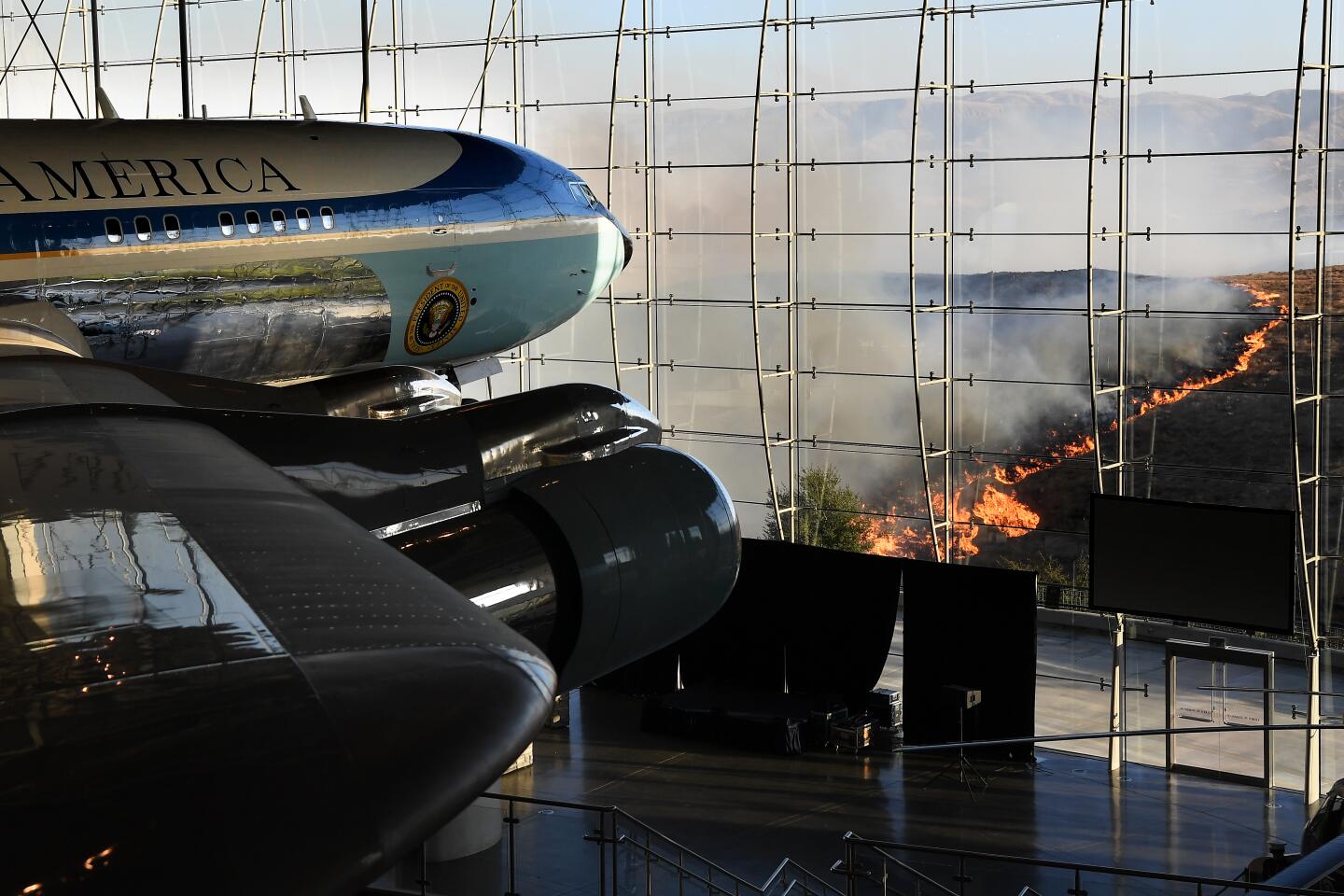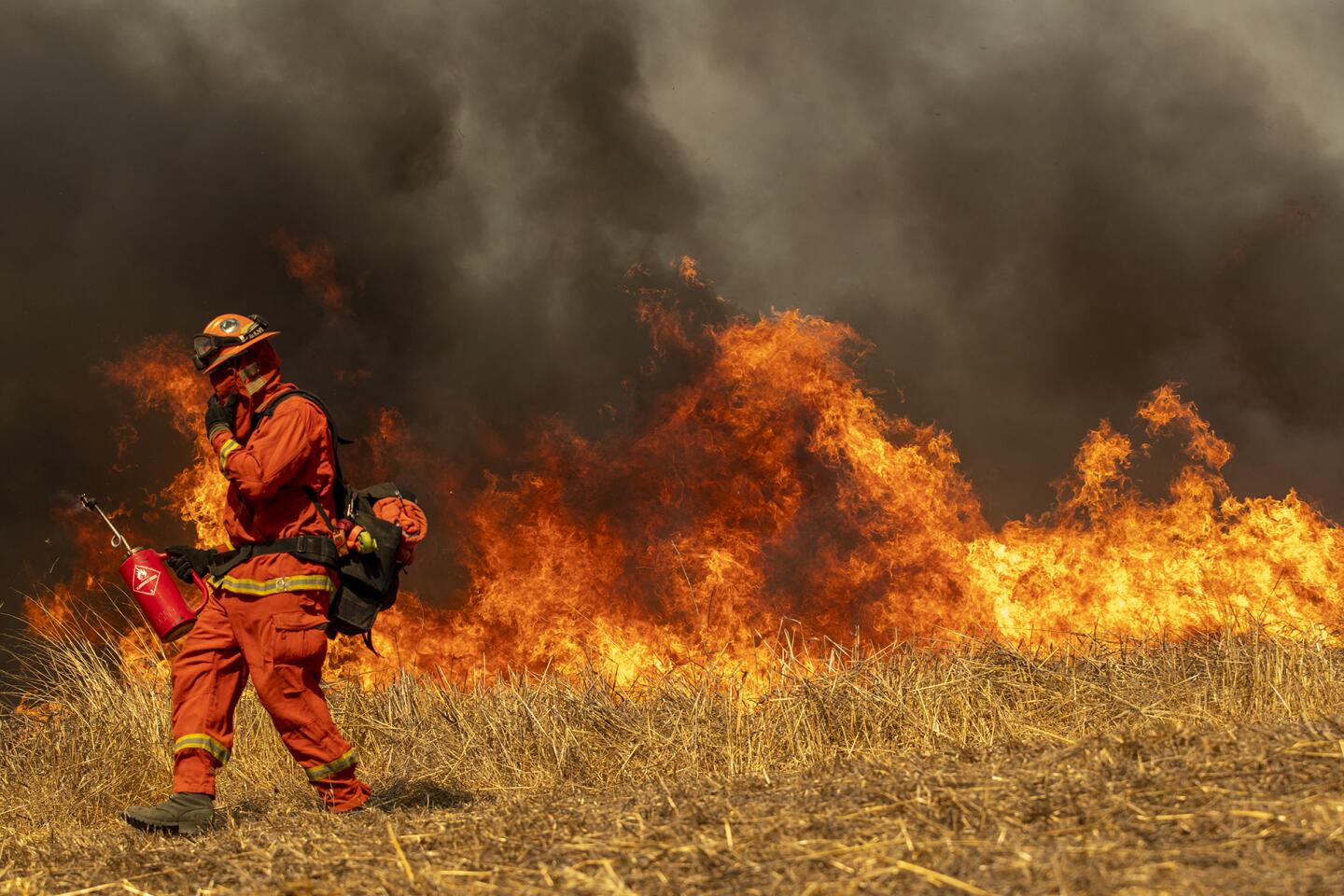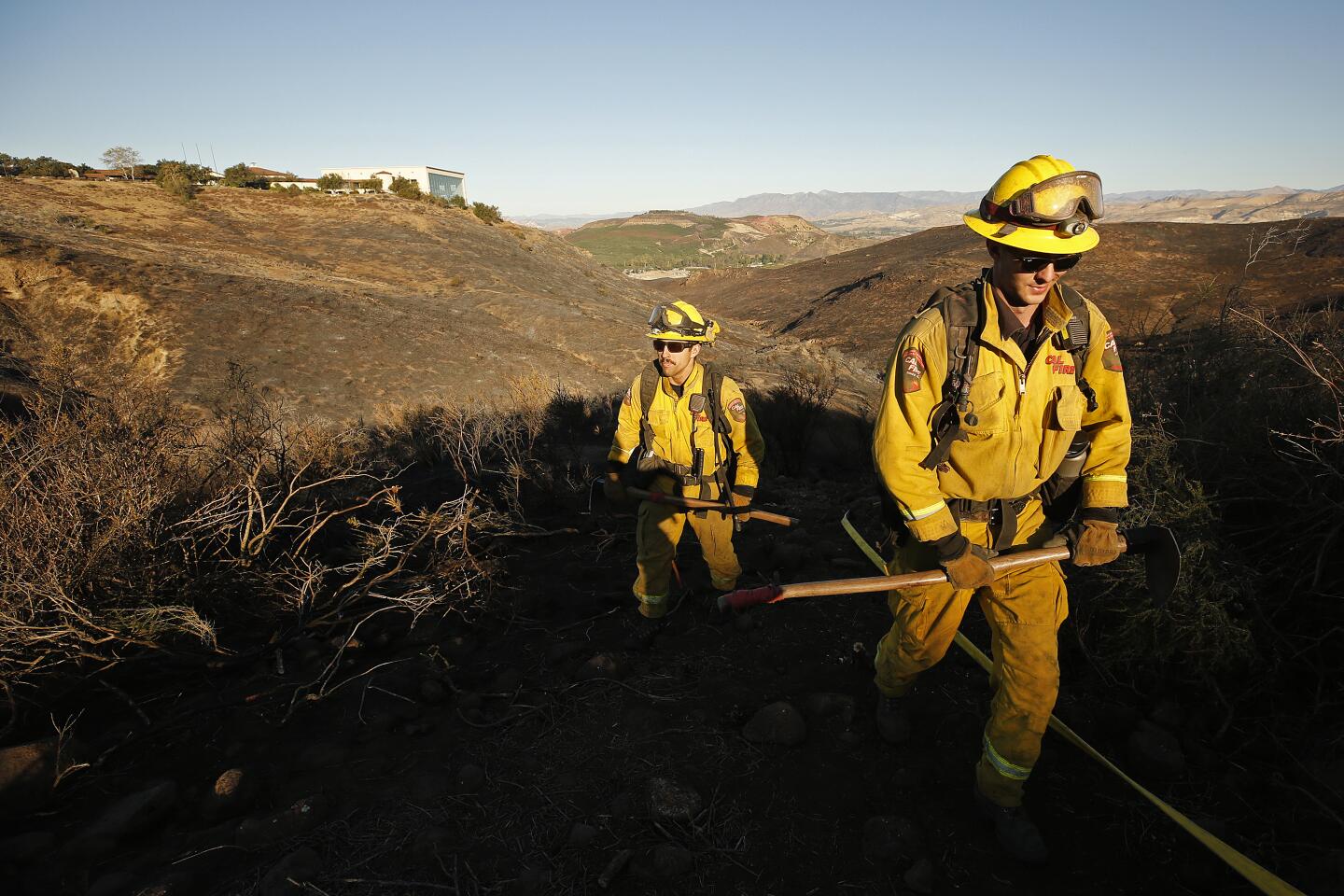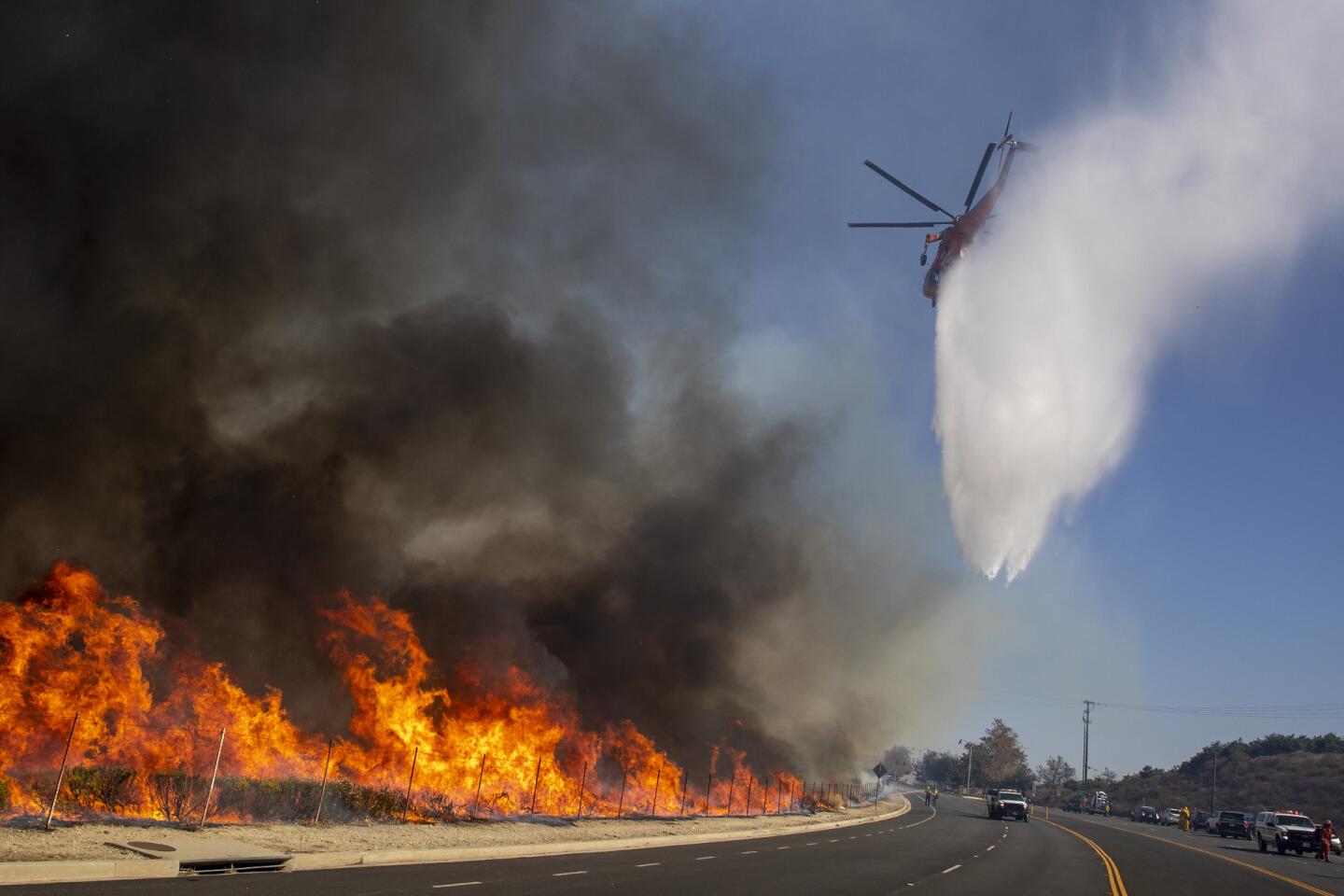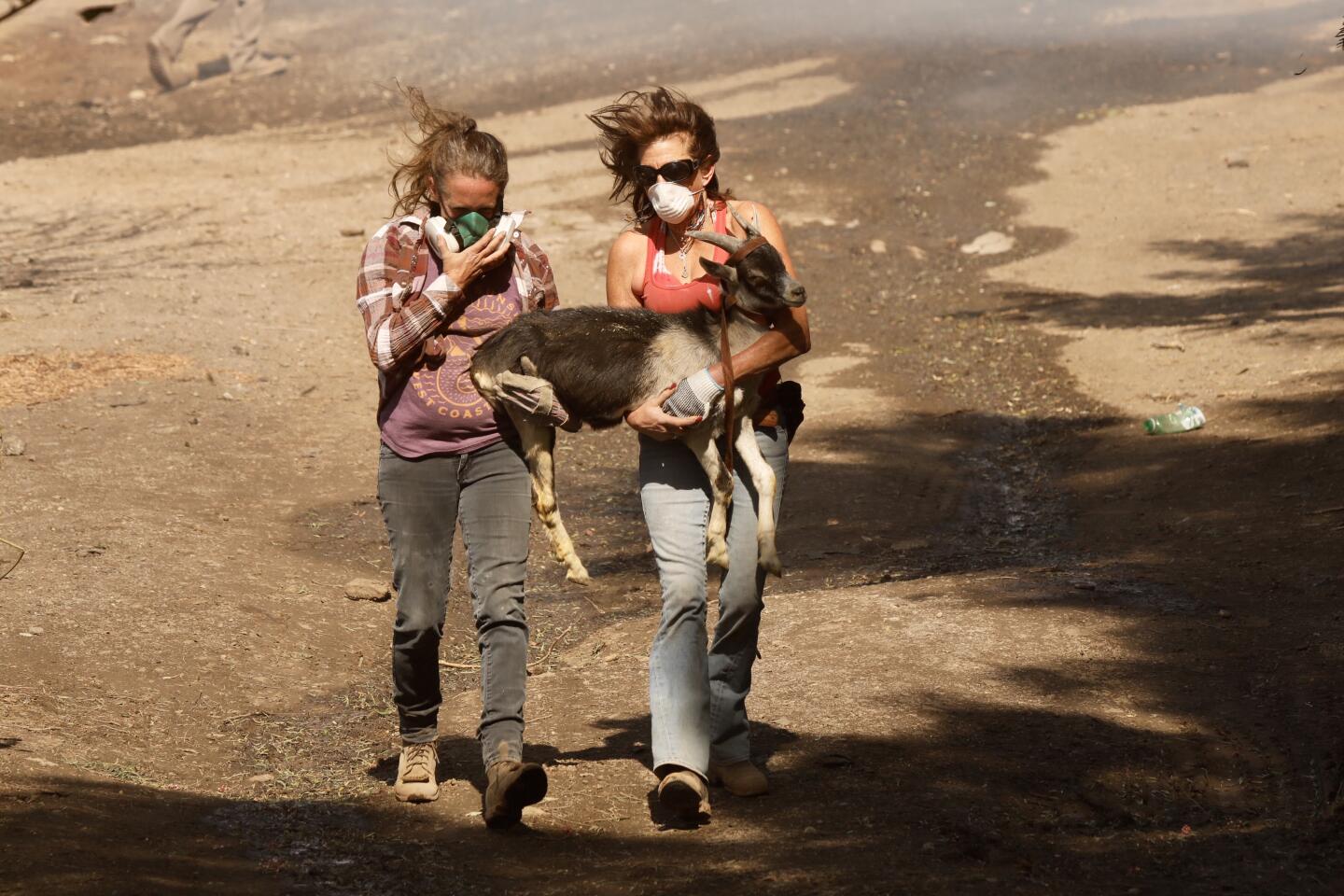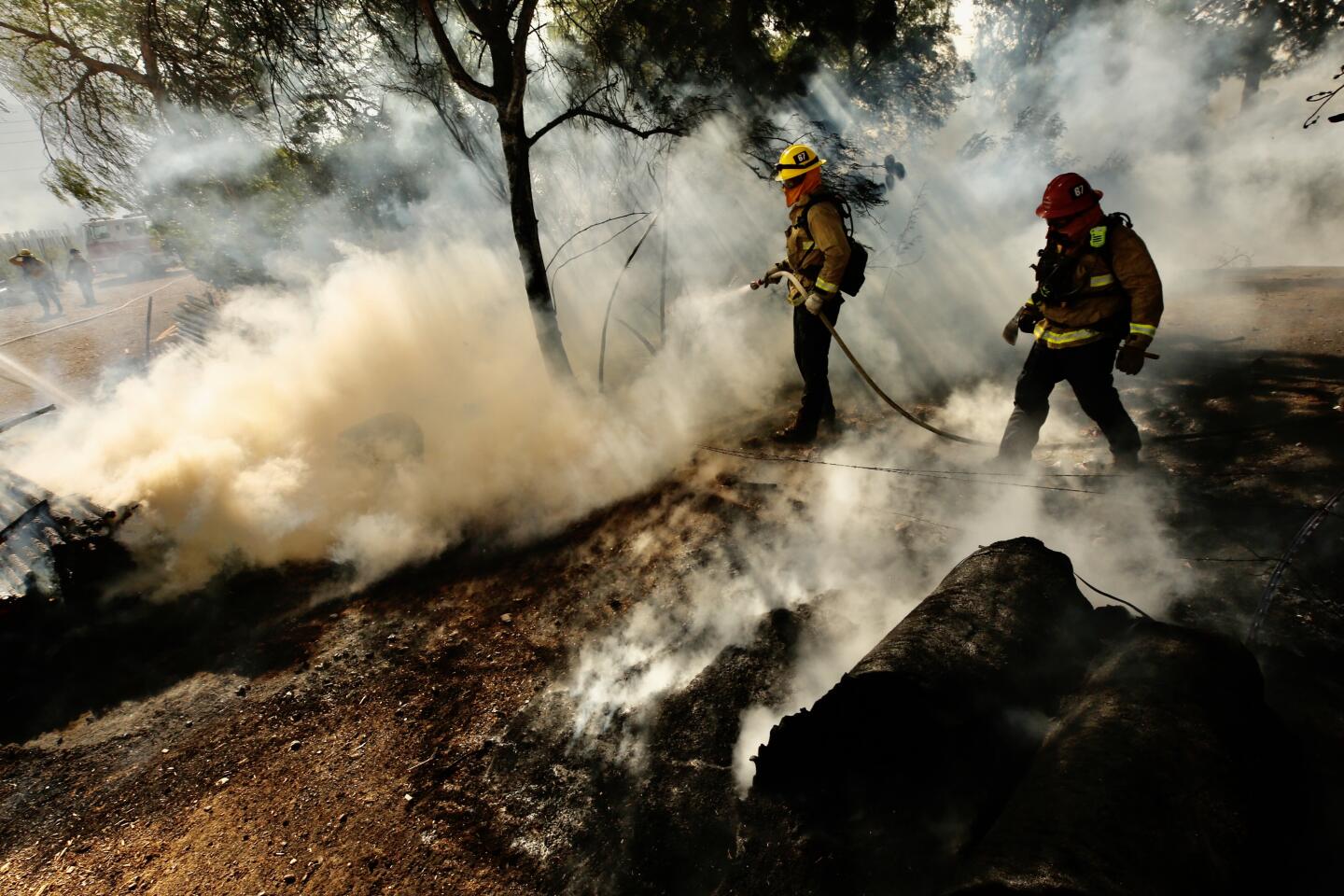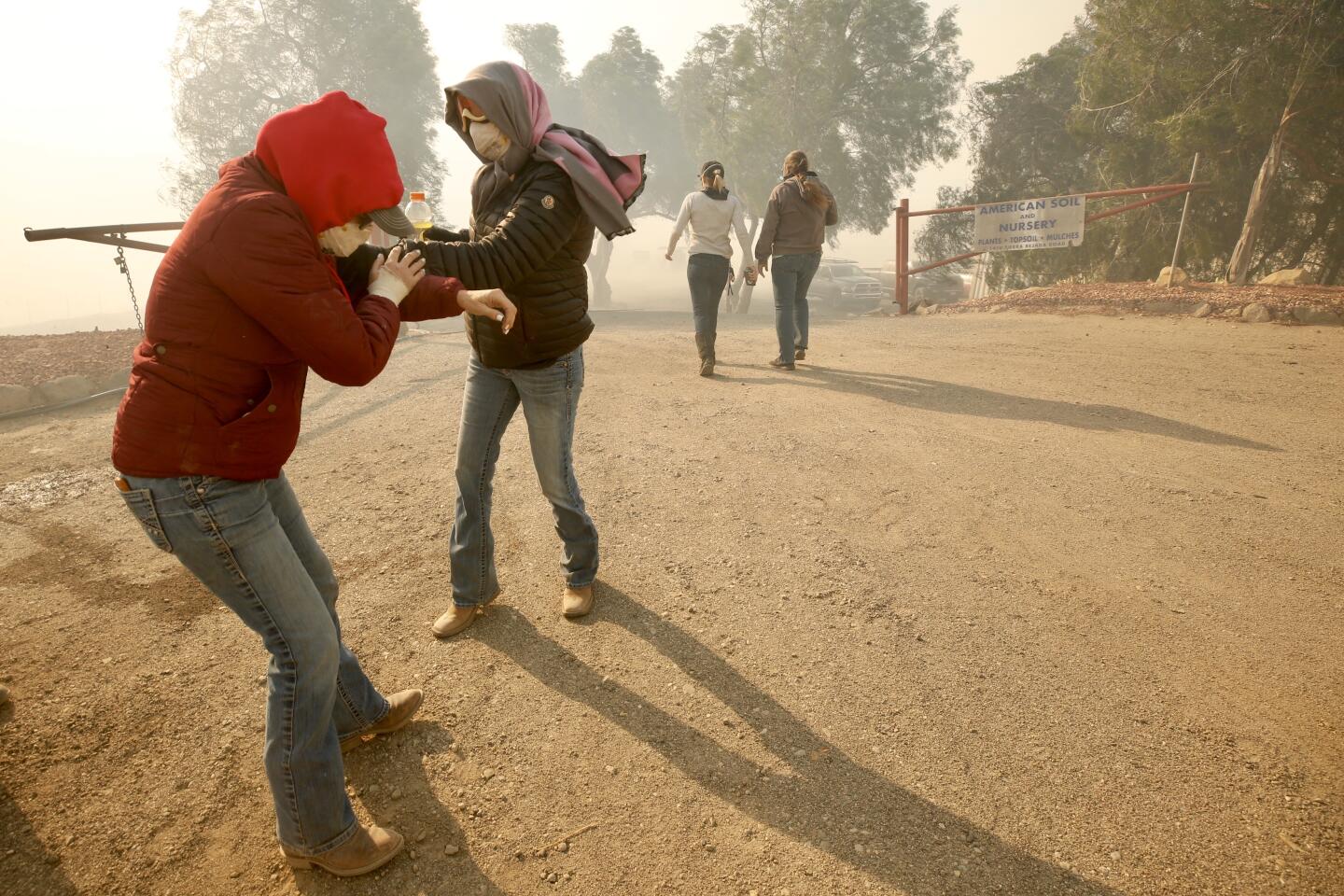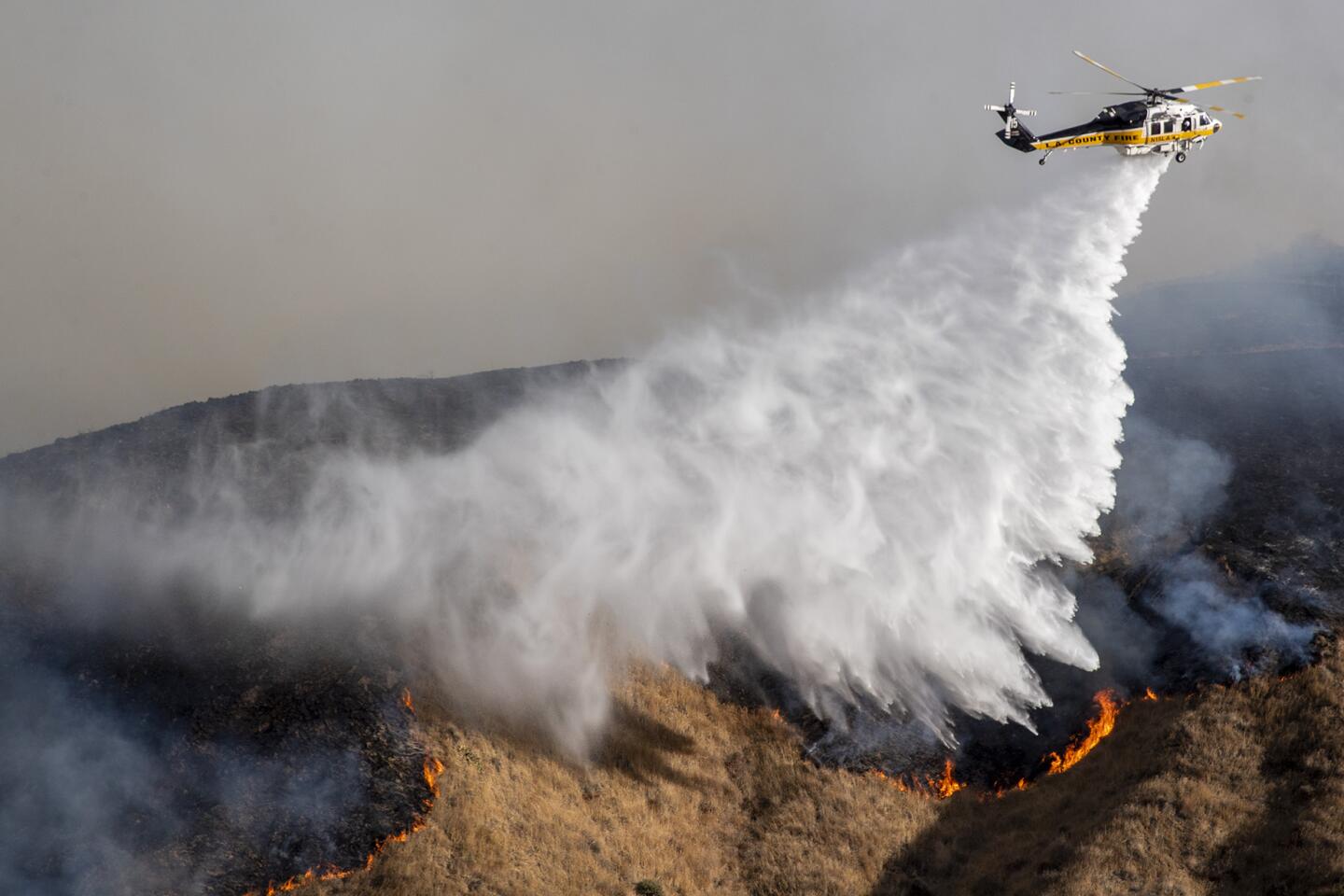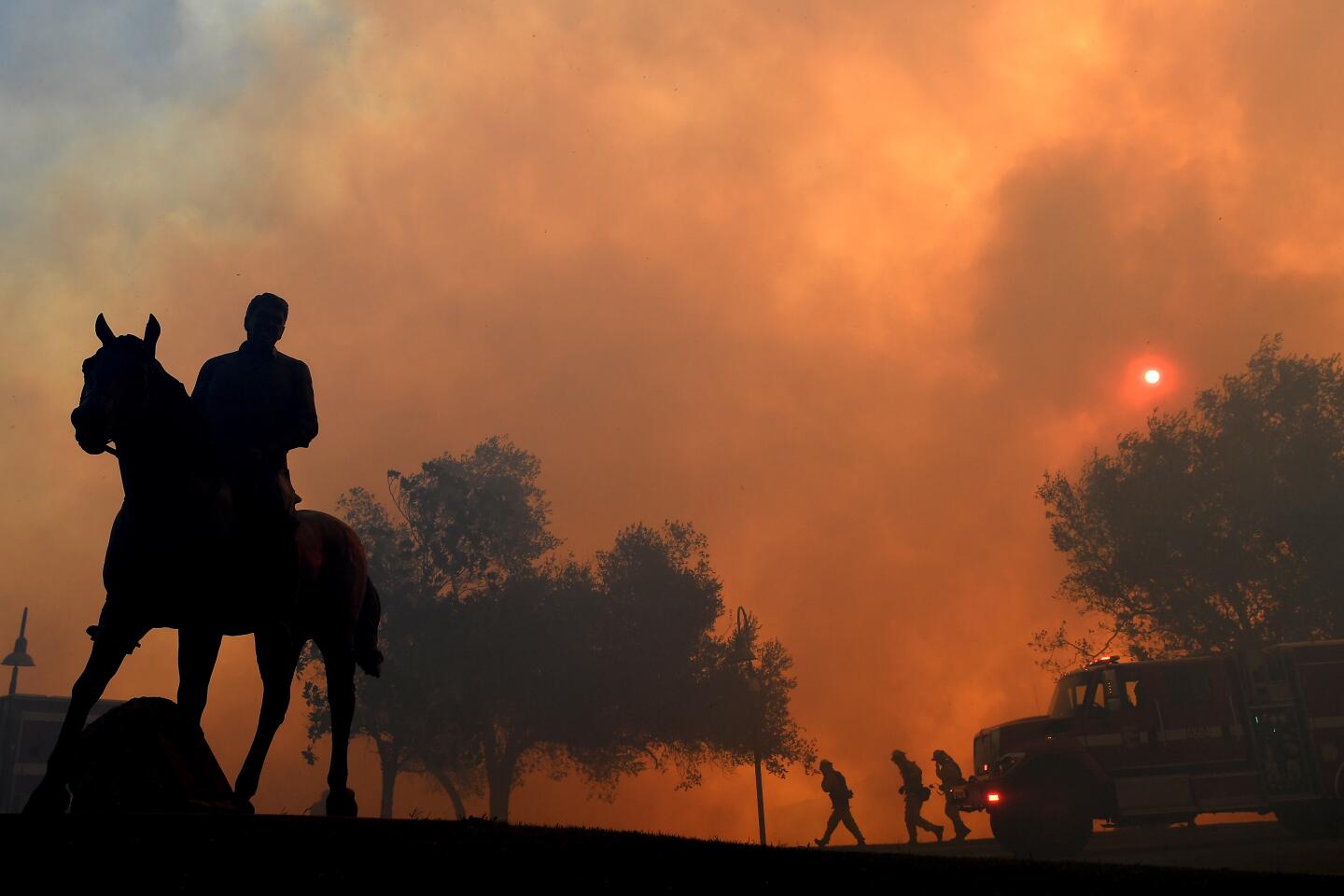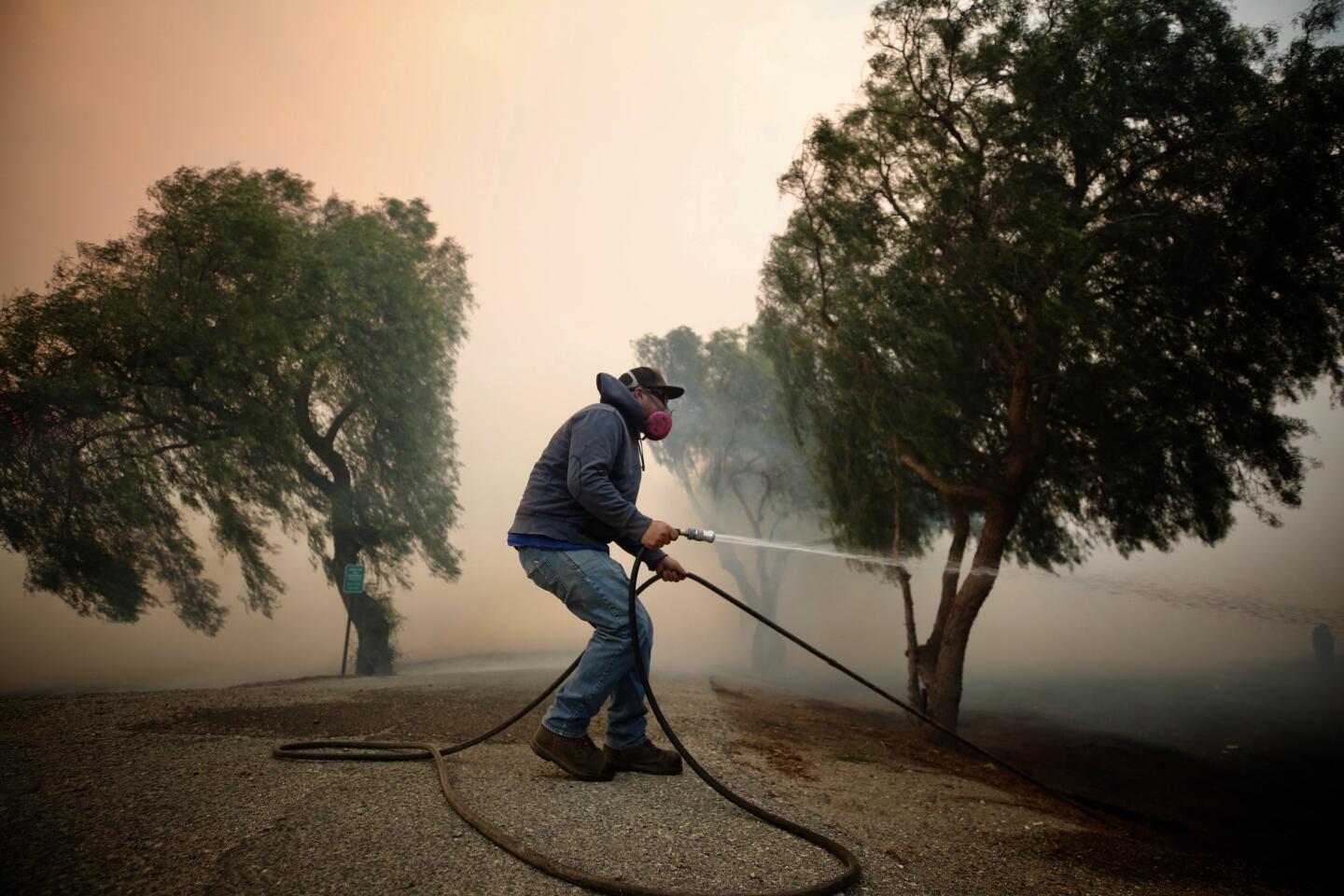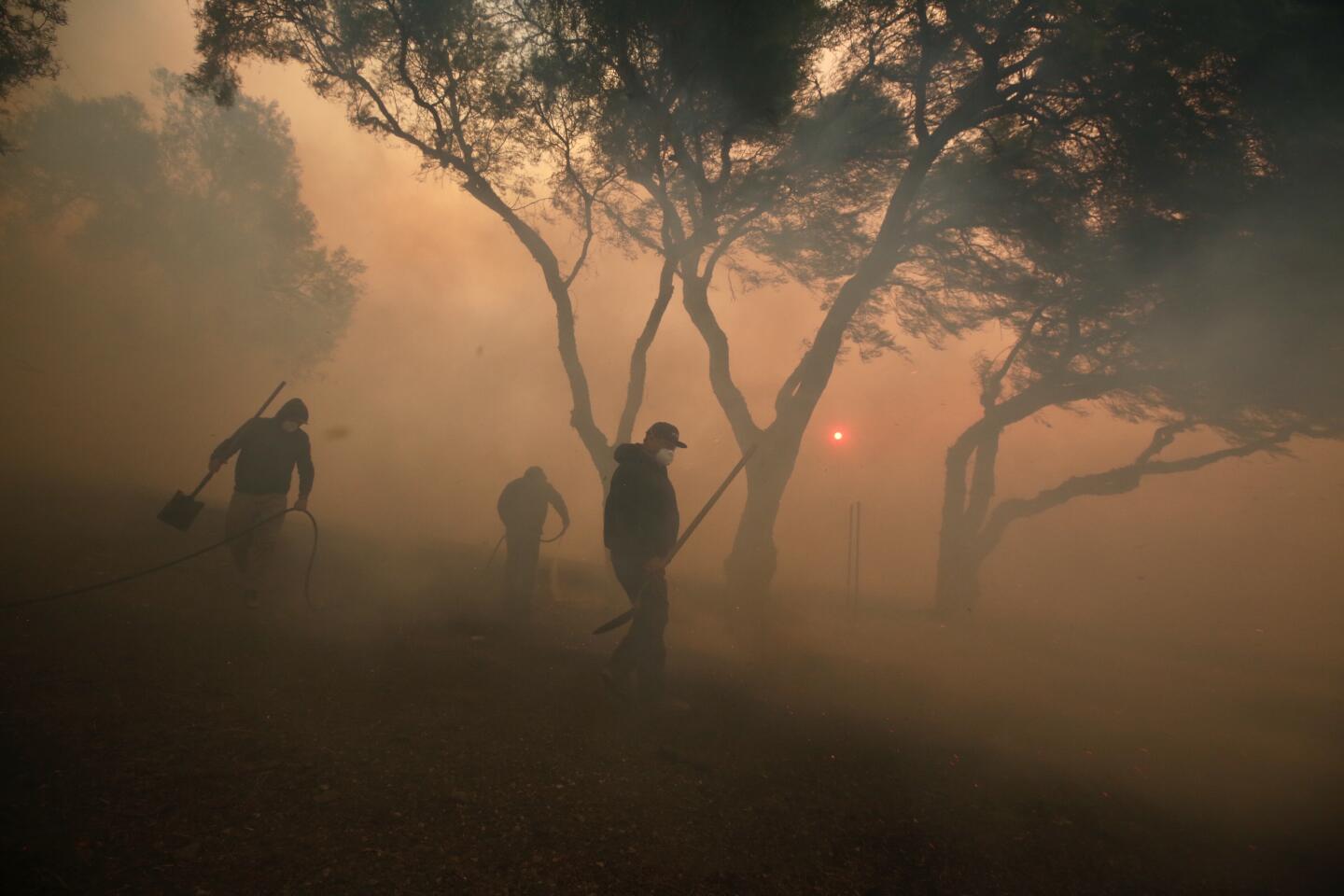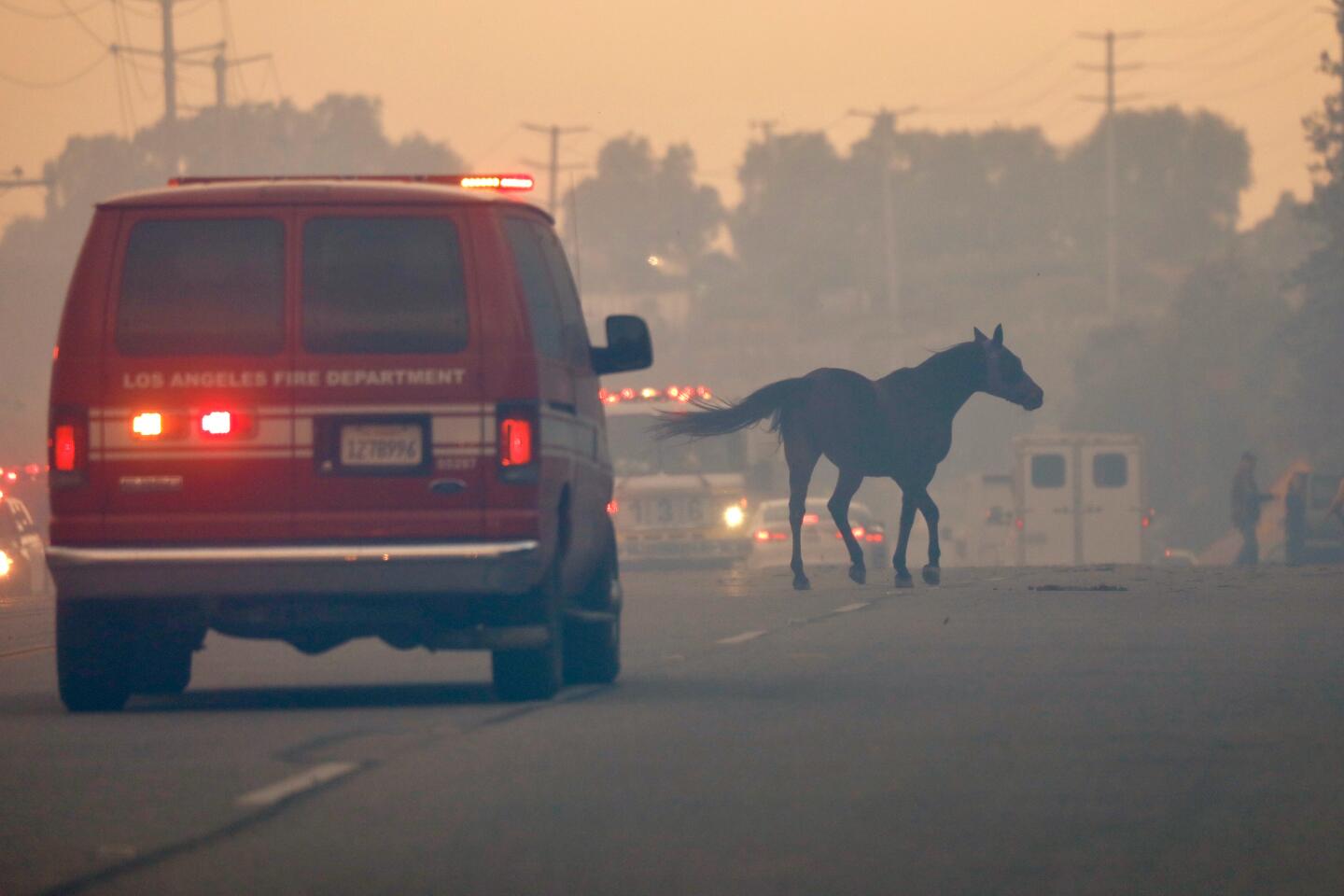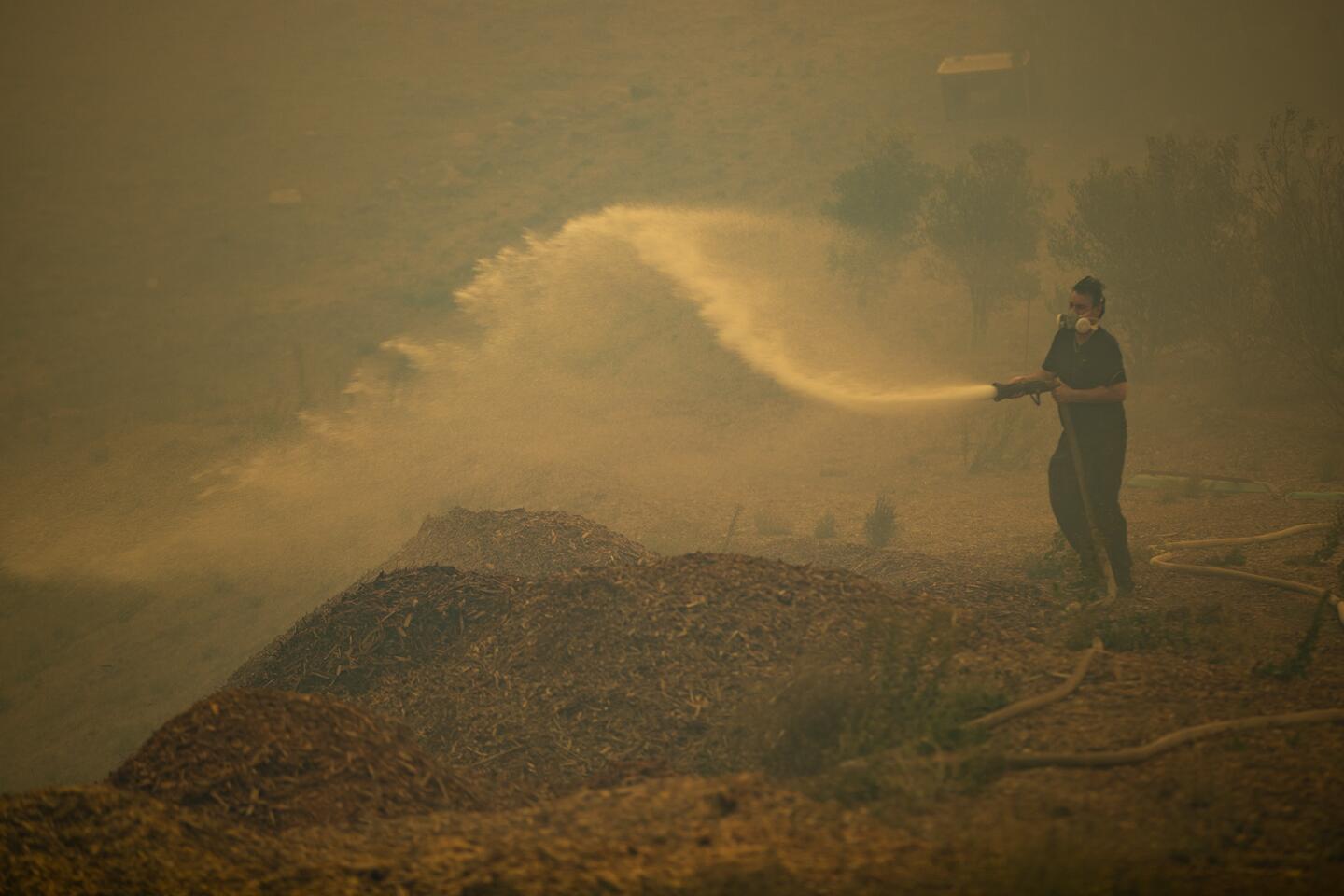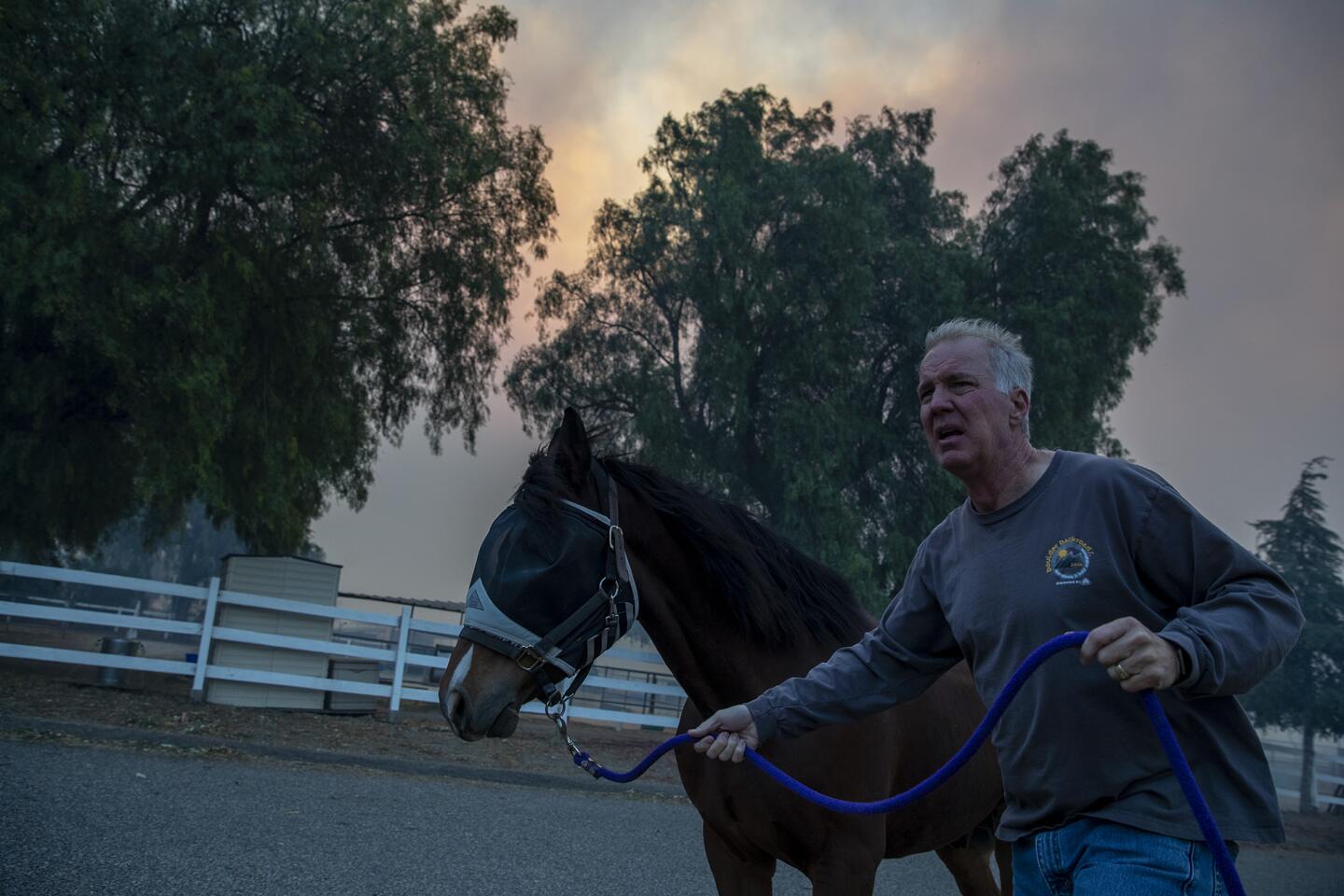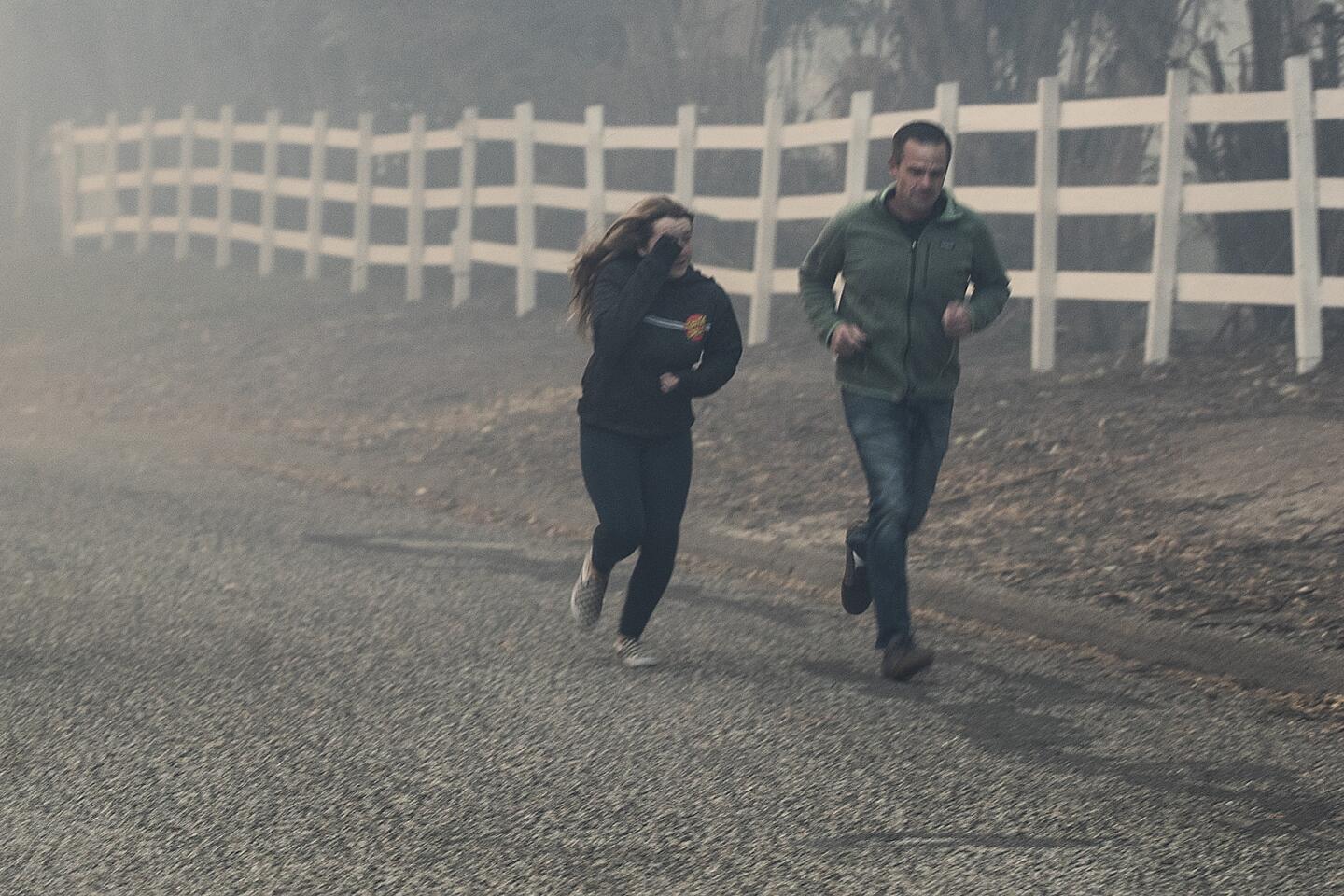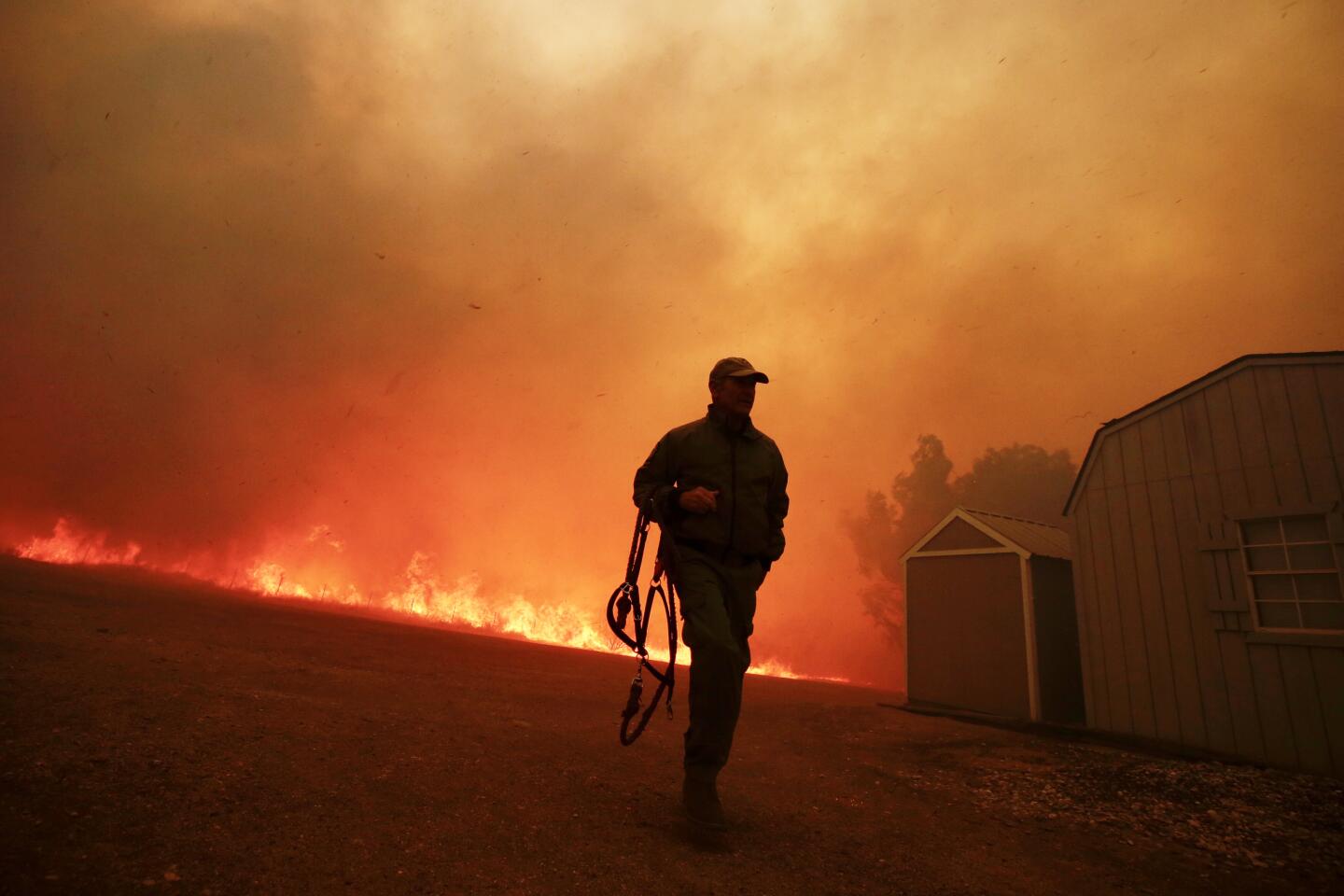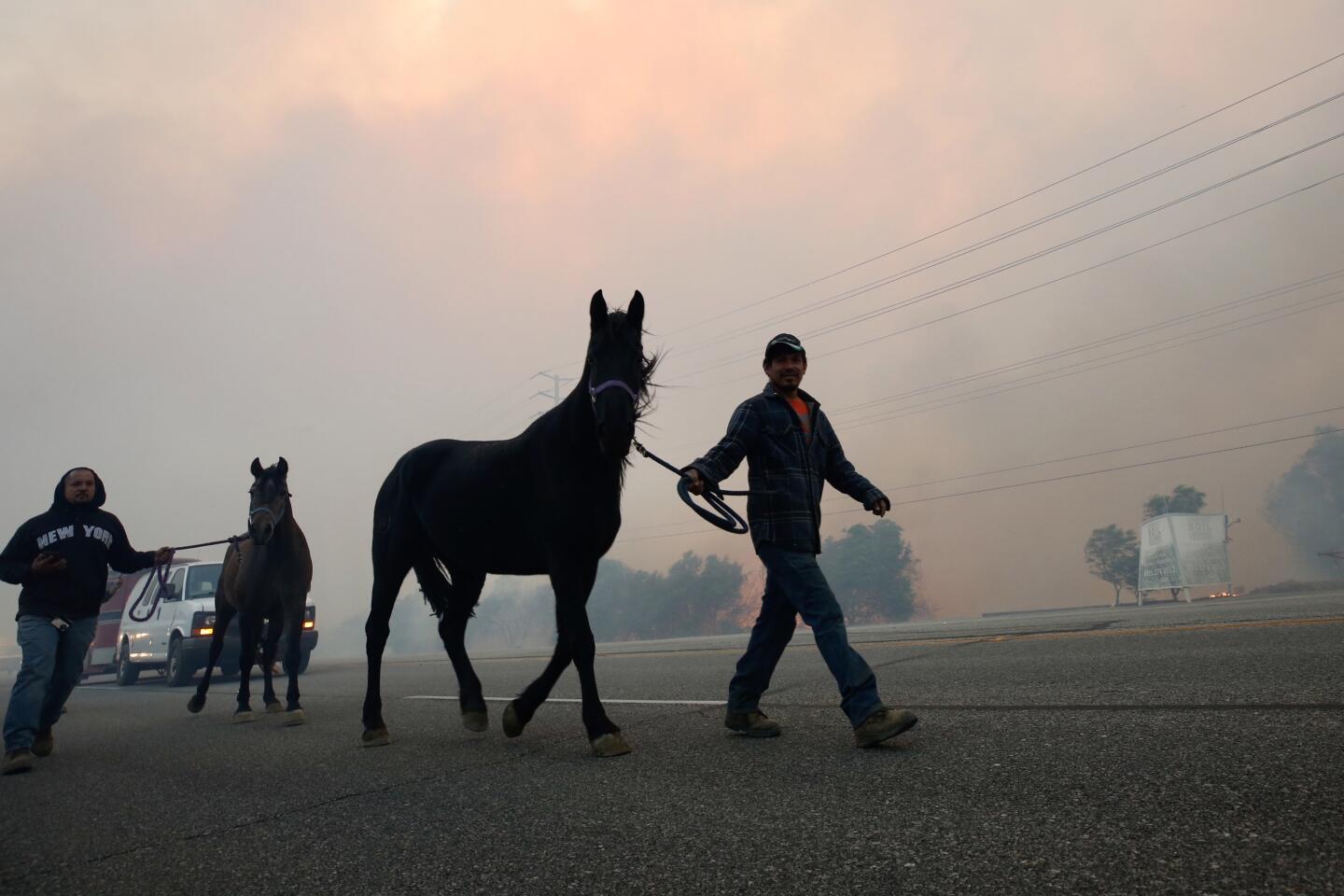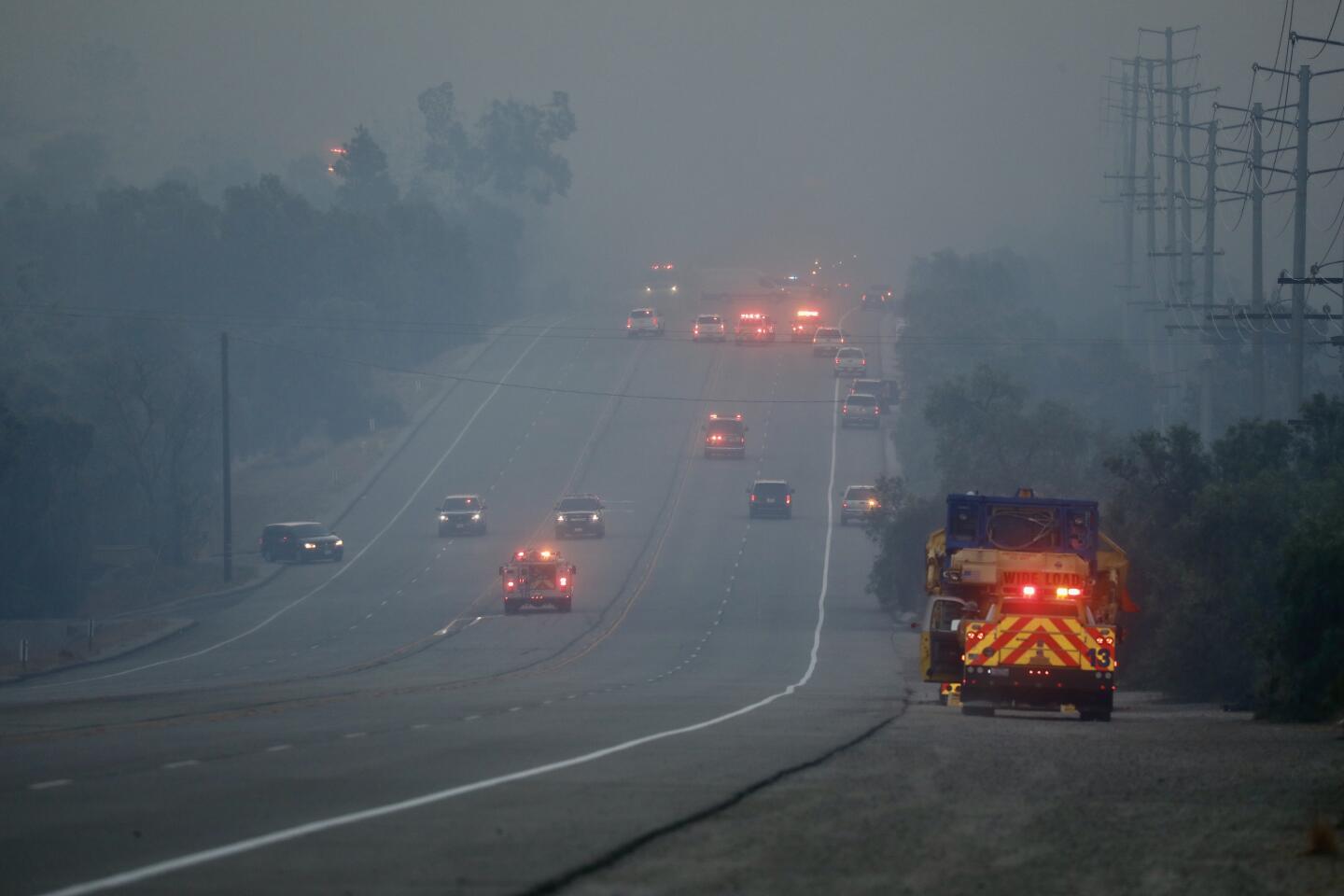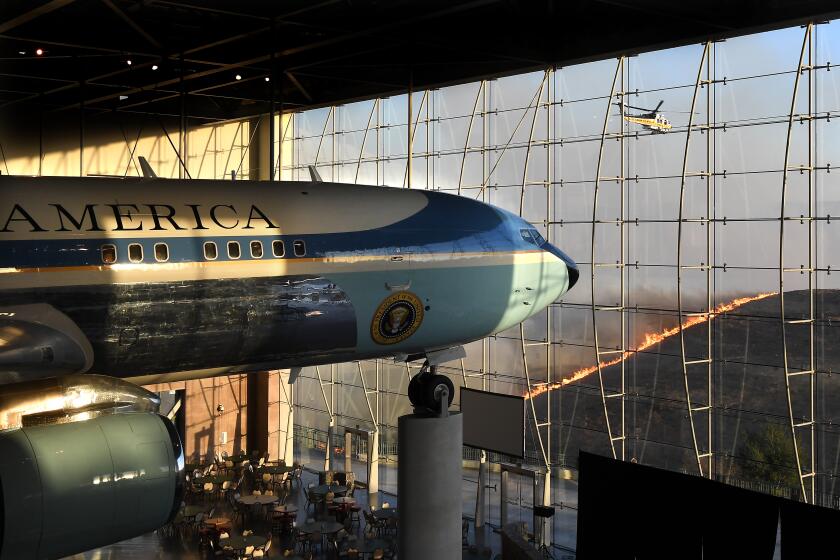Easy fire, burning out of control in Ventura County, started near Edison line, utility says

A major brush fire swept by gusts of Santa Ana winds up to 65 mph raced through Simi Valley hillsides toward neighborhoods Wednesday, threatening 7,000 homes and forcing thousands of residents to flee.
The Easy fire, which started near Easy Street and Madera Road shortly after 6 a.m., quickly burned toward Tierra Rejada Road, leaped across the street and made a run toward the Ronald Reagan Presidential Library, said Ventura County Fire Chief Mark Lorenzen.
“Unfortunately, it was about the worst time it could happen — 40-mile-an-hour sustained winds and fuels that were ripe and ready to carry fire,” he said.
Southern California Edison confirmed Wednesday evening that the fire broke out in its service territory near one of its subtransmission lines, which was not de-energized at the time of the eruption. The exact cause of the fire remains unknown.
The utility has notified the California Public Utilities Commission that there was activity on the subtransmission line near the reported time of the fire, spokesman Robert Villegas said.
Southern California Edison “is conducting a review into the circumstances surrounding the fire and will cooperate with all investigations into the origin and cause,” Villegas said. He said the utility’s top priority is the safety of its customers, employees and communities.
Thick smoke choked the hillside where the 125,000-square-foot library — a repository of records and artifacts from the Reagan administration — is perched amid dense brush. Flames burned on all sides, but the library has not sustained damage, officials said.
Shortly after 3 p.m., the fire jumped the 23 Freeway in the Moorpark area, where firefighters took a stand to prevent it from spreading west toward the Santa Rosa Valley. Crews pounced on the flames and extinguished the spot fire before it took hold, Lorenzen said at an evening news briefing.
“We have been able to at least defeat that part of the fire there and keep it from spreading toward the west,” he said.
The blaze, which has chewed through more than 1,600 acres of dense, dry brush, is also burning east toward homes along Madera Road. At least one home on Tierra Rejada was damaged and 7,000 others are threatened. Three firefighters are being treated at a local hospital for suspected smoke inhalation, authorities said.
About 30,000 residents in portions of Simi Valley, Moorpark and Thousand Oaks have been evacuated. “Be ready and prepared,” Lorenzen said. “When we ask you to leave, please leave immediately.”
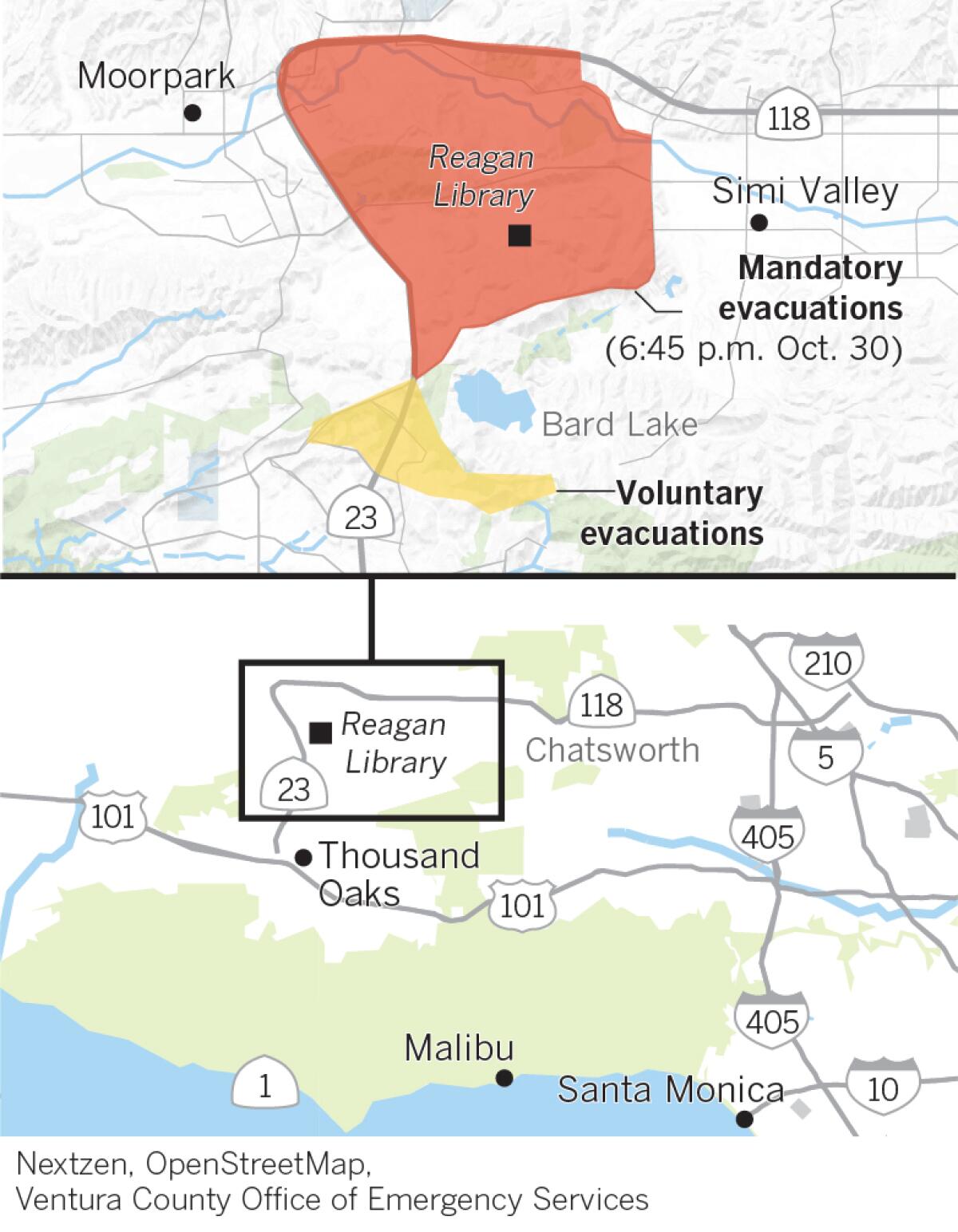
There was no containment of the fire as of Wednesday night. Although firefighters had bulldozer and hose line around a significant section of the blaze, they will not consider it contained until it has been wind tested for 12 hours. Fire officials anticipated the containment figure would increase Thursday, as long as things remain under control.
The size of the fire pales in comparison to Ventura County’s previous wind-driven monsters: the Thomas fire in 2017 that burned almost 282,000 acres and remains the second largest fire in the state’s modern history, and the Woolsey fire, the seventh most destructive fire in state history, which burned almost 97,000 acres in Ventura and Los Angeles counties and destroyed about 1,600 structures, including several homes.
Fire officials said this time was different, in part because of what they’ve learned from previous fires and because they had substantially more resources from the California Department of Forestry and Fire Protection and the Governor’s Office of Emergency Services.
Lorenzen said that given the extreme wind event warning, Cal Fire sent more firefighters to the region, and thanks to a recent boost in state funding, there were more strike teams that also came to the area.
Helicopters and fixed-wing aircraft were also crucial, as they aided ground crews in keeping the fire skinny, Lorenzen said.
“They worked the flanks pretty hard, and then they were incredibly vital when the fire crossed the 23,” Lorenzen said. “We had the DC-10 come in and lay down retardant along the 23 and then right in that neighborhood above it, and it gave us the opportunity to get in there and knock it down. In the absence of the aircraft there, that would have been a really big challenge for us to contain that fire.”
The efforts of 800 firefighters, eight air tankers and nine helicopters trying to get control of the fast-moving blaze were stymied through the morning by extreme wind conditions.
The fire quickly outflanked crews as gusts picked up embers and carried them through the air. Wind-driven embers have been known to blow miles ahead of the front line of a blaze, setting spot fires and igniting homes. For that reason, officials cautioned people near the evacuation zones to keep their doors and windows closed.
Tanker aircraft dropping water and fire retardant were forced to divert from the area periodically because of turbulence, officials said.
“The [conditions for] air assets are challenging at best,” Ventura County Fire Capt. Steve Kaufmann said. “You can see a lot of the water that’s coming from the ‘super scoopers’ is atomized because of the wind. It definitely makes it challenging for us.”
Ventura County Assistant Fire Chief Chad Cook said significant manpower was devoted to areas near the Reagan Library through the morning to protect the landmark. Helicopters repeatedly dropped loads of water behind the library amid 60-mph winds, turning the flames into smoke on a ridge 300 feet below. As wind gusts blew strong enough to knock a person off balance, two ‘super scooper’ planes dipped down behind the library, unleashing a large volume of water that created its own rainbow.
With fire sweeping down the ridge toward Roosevelt Court, an off-duty LAPD officer began yelling, alerting residents that the blaze was headed down the hill. Tensions immediately heightened as the flames became visible to homeowners.
Rory Kaplan has lived on Roosevelt since the homes were built there in 2001.
“I got the reverse 911 about 6:30 a.m.,” he said. “I pulled the cars out into the driveway, put the passports and bank documents in one and my musical instruments in the other car. I am ready to go.”
Times staff photographer Wally Skalij has covered many wildfires for the paper. On Monday, he went to Simi Valley for the Easy fire, where he got a notable shot.
Simi Valley police began directing everyone via loudspeaker to leave the neighborhood behind the Reagan Library. Kaplan joined the exodus.
“One thing is sure,” he said. “They aren’t going to let Reagan’s library burn — and that protects us.”
Just south of Madera Road, a group of neighbors stood in an intersection in the Village on the Green neighborhood in the Wood Ranch area, watching the fire crawl down nearby hillsides and waiting to see whether they would be evacuated.
Helicopters flew close overhead, the sound of their engines echoing as they dumped load after load of water on the blaze. The wind ebbed and flowed through the neighborhood, shooting cold air past the group.
“I’m not so nervous, but my wife is,” Erik Roodman, 54, said as he watched the action. “She already has a bag packed. I just made sure I had clean clothes on in case I need to go.”
Hours earlier, thousands of residents fled their homes as wind-whipped flames rapidly consumed large swaths of brush, casting hillsides in an orange glow.
All Simi Valley public schools were closed because of the fire, and a shelter has been set up at the Thousand Oaks Community Center at 2525 N. Moorpark Road.
Kris Mae, 69, was one of the first people to arrive at the community center. Mae, an early riser, had been watching television on mute and listening to the radio when she heard the announcer say there was a fire near the Reagan Library — about four miles from her house. Outside, she saw a beige-and-red-hued plume of smoke.
“I’m right in the path,” she said. “That’s why I left my house, because it was so close.”
But she was prepared. She had packed her car with several suitcases, boxes of important files and a fire safe about a month ago when the first major fires of the season started.
“It’s too hard to pack and unpack over and over,” she said. “I’m a very nervous person when I get shaken.”
Chandler Collins, 23, was jolted awake early Wednesday by the sound of his grandmother banging on his door. They had to evacuate.
It was still dark outside, but he could see flames licking uphill near their home, which is on the same road as the Reagan Library. He threw together some clothing, pet supplies for his cat, Shadow, and his chinchilla, Rocket, plus his Halloween costume, in case he couldn’t make it back home before his dress-up day at work Thursday.
“I’ve never done this before, but it’s probably going to happen more often,” he said of the evacuations.
When the Easy Fire erupted early Wednesday morning in Simi Valley, a priority quickly arose: Save the Ronald Reagan Presidential Library.
The Easy fire was one of several blazes that broke out across Southern California on Wednesday.
Throughout the day firefighters converged on multiple blazes throughout the region — the Hill fire in Jurupa Valley in Riverside is the largest of the others at 200 acres and at times closed the 60 Freeway. Fires broke out in Whittier Narrows, Brea, Calabasas and at least one other in Riverside.
The new fires come amid dangerous weather conditions and the threat of more intentional power blackouts as utility companies attempt to reduce wildfire risk.
In the area of the Easy fire, gusts of about 30 mph from the northeast were reported nearby around 8 a.m., National Weather Service meteorologist Lisa Phillips said.
By midday Wednesday, Southern California was facing peak fire weather, with winds of up to 78 mph at Boney Peak in the Santa Monica Mountains in Ventura County, while relative humidity fell to rock bottom, clocking at zero at Mt. Wilson in the San Gabriel Mountains and peaks in the Santa Ynez Mountains and the Los Padres National Forest, Phillips said.
The air was exceedingly dry throughout Ventura County. Relative humidity was 8% at Sinaloa Lake and 7% in Moorpark.
Forecasters said the winds would be the strongest to hit the region in recent memory.
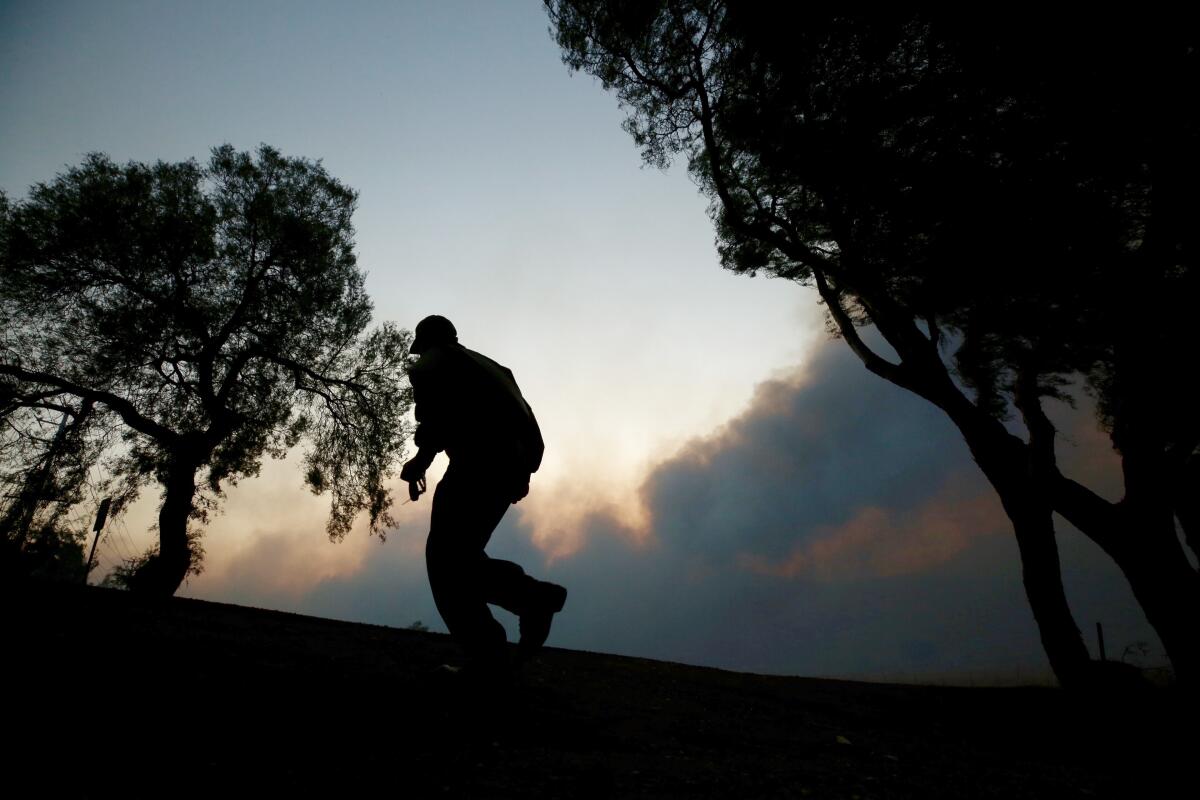
“The magnitude of the wind gusts really is going to be a concern,” said Daniel Swain, climate scientist with UCLA and the National Center for Atmospheric Research. “The actual winds that people experience really will be quite extreme in a lot of places, really everywhere except for the wind-sheltered parts of downtown L.A. and central L.A.”
The extreme fire weather conditions are expected to persist through Thursday evening, the National Weather Service said. While Santa Ana winds have likely peaked, they’ll still be strong, with expectations of gusts between 40 mph and 60 mph.
It’s also possible that red flag warnings — a term used to describe critical fire weather danger from a combination of high winds, low humidity and dry vegetation — will be extended for valley hills and mountains beyond Thursday afternoon. On Thursday night through Friday, top winds will weaken to gusts of 25 mph to 35 mph.
Southern California is expected to get a break from Santa Ana conditions next week. Unfortunately, there is no outlook for rain over the next 10 days.
The forecast of extreme Santa Ana winds prompted Southern California Edison to say it might shut off power to more than 340,000 customers in Los Angeles, Ventura, Santa Barbara, San Bernardino and Riverside counties.
To the north, Pacific Gas & Electric Co. said Wednesday that it would begin restoring power to customers who were shut off this week in its latest bid to reduce wildfire risk. Crews will inspect utility lines, repair damage and restore power to about 365,000 customers in its service area, except for Kern County, which is still experiencing strong winds, according to PG&E.
Fire danger from power lines was underscored Tuesday when L.A. officials said a Los Angeles Department of Water and Power line hit by a tree branch sparked the Getty fire.
Times staff writers Rong-Gong Lin II and Alejandra Reyes-Velarde contributed to this report.
More to Read
Sign up for Essential California
The most important California stories and recommendations in your inbox every morning.
You may occasionally receive promotional content from the Los Angeles Times.
